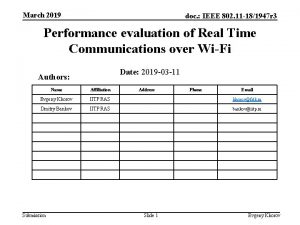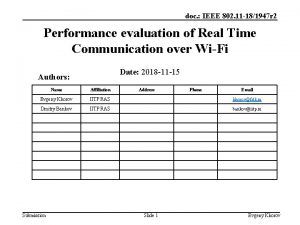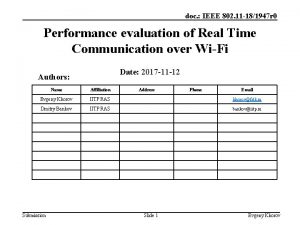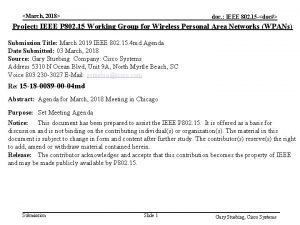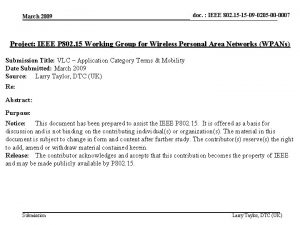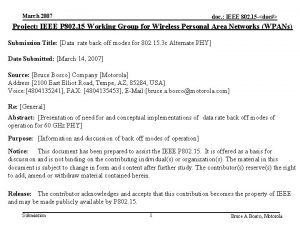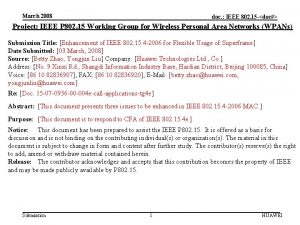March 2019 doc IEEE 802 11 181947 r











- Slides: 11

March 2019 doc. : IEEE 802. 11 -18/1947 r 4 Performance evaluation of Real Time Communications over Wi-Fi Date: 2019 -03 -11 Authors: Name Affiliation Evgeny Khorov IITP RAS khorov@frtk. ru Dmitry Bankov IITP RAS bankov@iitp. ru Submission Address Slide 1 Phone Email Evgeny Khorov

March 2019 doc. : IEEE 802. 11 -18/1947 r 4 Contribution This document describes two ways of how to organize real -time communications in IEEE 802. 11 networks and evaluates their performance in simple scenarios Submission Slide 2 Evgeny Khorov

March 2019 doc. : IEEE 802. 11 -18/1947 r 4 Outline 1. Preemptive Service 2. AX-like approach 3. Simulation results Submission Slide 3 Evgeny Khorov

March 2019 doc. : IEEE 802. 11 -18/1947 r 4 What makes Wi-Fi not Real-Time Packet Delay = Queueing Delay + Packet Transmission Time A real-time (RT) packet shall wait while at least the head-of-line packet is being transmitted Packet Transmission Time includes channel access time and PPDU duration (plus retries, if any) Maximal PPDU duration in 11 ax exceeds 5 ms Because of unlicensed spectrum, the channel may be busy with transmission of other devices Submission Slide 4 Evgeny Khorov

March 2019 doc. : IEEE 802. 11 -18/1947 r 4 Reducing Queueing Delay Main idea: Stop transmitting a non-RT frame when an RT frame arrives. • This is similar to IEEE Std 802. 1 Qbu-2016 A STA can easily stop its own frame, but how to stop other frame transmissions Submission Slide 5 Evgeny Khorov

March 2019 doc. : IEEE 802. 11 -18/1947 r 4 Preemptive service. Own RT packet Main idea: to minimize channel access delay, stop transmitting a non-RT frame when a RT frame arrives. RT packet arrives in the queue of the same STA Data Time Data Real Time Data SIFS Ack Time [1] WTSN (Wi-Fi Time Sensitive Networking) doc. : IEEE 802. 11 -17/1734 r 1 Submission Slide 6 Evgeny Khorov

March 2019 doc. : IEEE 802. 11 -18/1947 r 4 Preemptive service. Alien transmission RT packet arrives in the queue of another STA Non-RT STA Data Channel is busy Time IFS RT STA SIFS Data Ack Busy tone in the service channel Time The RT STA generates busy tone in the service channel when it has an RT frame. Any ongoing transmissions should be cancelled. If no busy tone is in the service channel, the RT frame can be transmitted PIFS after the main channel becomes idle. Otherwise, RT frames contend for the channel access according to EDCA (high priority queue) [1] WTSN (Wi-Fi Time Sensitive Networking) doc. : IEEE 802. 11 -17/1734 r 1 Submission Slide 7 Evgeny Khorov

March 2019 doc. : IEEE 802. 11 -18/1947 r 4 AX-like approach Frequency RU m … TF MSBA RU 2 Other Transmissions TF RU 1 Time SIFS Trigger Frame SIFS Multi Station Block-Ack Resource Units Assigned to specific STAs or Random Access (RA) The AP periodically generates TF Submission Slide 8 Evgeny Khorov

March 2019 doc. : IEEE 802. 11 -18/1947 r 4 AX-like approach. Possible Algorithm Frequency RU m T F … RU 2 RU 1 M S B A RU m T F M S B A … RU 2 RU 1 is for RT Random Access RU 2…m are used for usual DATA or RT DATA. RU duration is short enough to allow 3 TX within delay budget. Submission Slide 9 Time Evgeny Khorov

March 2019 doc. : IEEE 802. 11 -18/1947 r 4 AX-like approach. Possible Algorithm Non-RT RU RU m … RU 2 STAs: m, 2 m, … … STAs: 2, m+2 , … STAs: m STAs: 2 m STAs: m+2 RU m … RU 2 RU 1 RU 0 STAs: 1, m+1 , … RU 0 STAs: 2 RU 0 RU 1 RU 0 STAs 1, 2, m, 2 m transmit RT frames Apart from that, STA m+2 transmits. Submission RT RA RU, idle RT RU, success RT RU Collision Time By default, the AP allocates 1 RUs for random access In case of collision, the remaining m RUs are allocated for RA RT uniformly for those STAs, which might participate in the collision If the number of RT STAs is greater than m, each RU is allocated for several STAs Slide 10 Evgeny Khorov

March 2019 doc. : IEEE 802. 11 -18/1947 r 4 Performance evaluation 1 AP, 10 non-RT STAs transmitting frames in saturated mode N RT STAs generate 32 B frames (Poisson process with λ-1 = 50 ms) All STAs use MCS 5 If a frame is not delivered within 1 ms, it is dropped. Tdata= 0. 9 ms (non-OFDMA), Trt= 0. 06 ms, Period of RUs = 0. 28 ms, BW=40 MHz, Nru=18 Portion of throughput for usual DATA Packet loss ratio (both collisions and drops) Submission Slide 11 Evgeny Khorov












